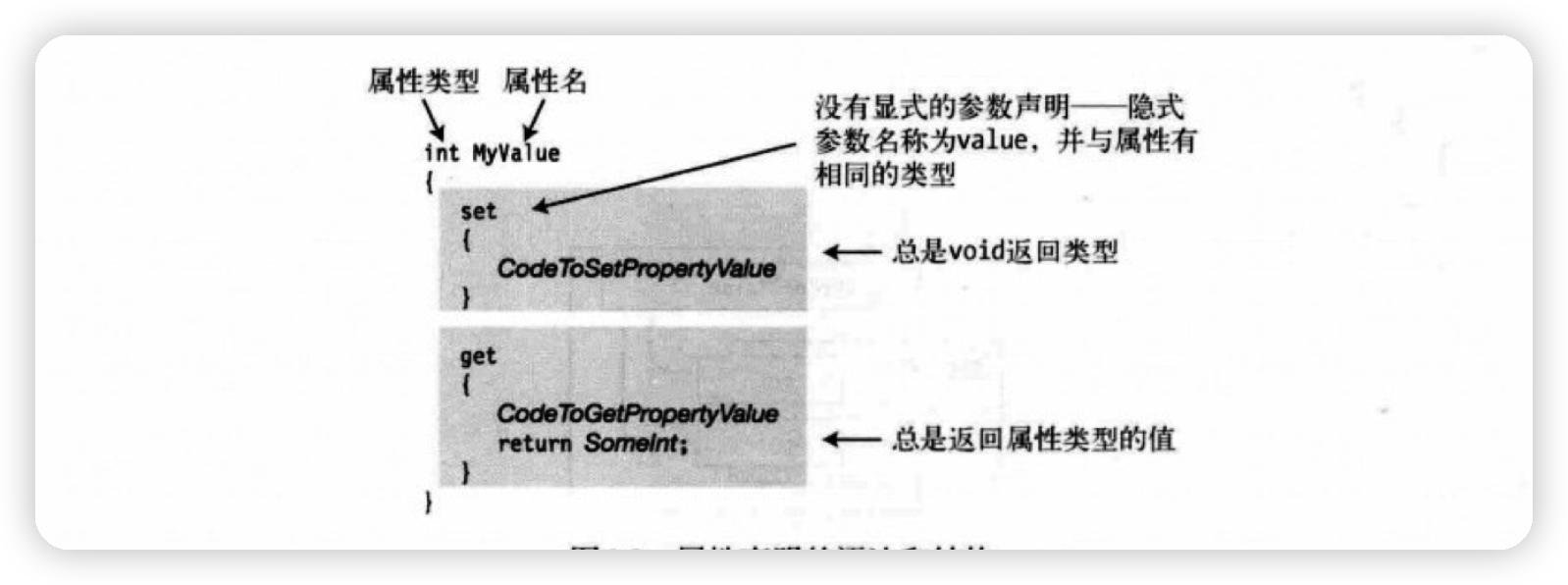类成员 数据成员
函数成员
静态成员 static 修饰
类的所有实例共享静态成员。
这也就导致了如果我们修改静态成员时,其他实例读到到也是这个修改的。即数据只有一份。
静态成员的生命周期和实例没有关系 。即实例是否产生或销毁对静态成员没有影响。
static 修饰的为静态成员
声明 d1、d2 两个实例,在右图的堆里会开辟两个空间去存放两个实例。每个实例都有自己的实例成员Mem1。
共用Mem2静态成员。
常量成员 常量成员不能声明为静态成员。
与本地常量类似,用于初始化成员常量的值在编译时必须是可计算的,通常是一个预定义的简单类型或由他们组成的表达式。
“然而,成员常量比本地常量更有趣,因为它们表现得像静态值。它们对类的每个实例都是“可见的”,而且即使没有类的实例也可以使用。与真正的静态量不同,常量没有自己的存储位置, 而是在编译时被编译器替换。这种方式类似于C和C++中的#define值。”
1 2 3 4 5 6 7 8 9 10 static const double PI 3.14 ; class MyClassContainer { static public int Var = 1 ; public const int Var1 = 2 ; } MyClassContainer.Var1
属性 类成员
属于函数成员
包括两个访问器 (get set)
最少保留一个访问器
只有 get 代表属性只读
属性不分配内存
1 2 3 4 5 6 7 8 9 10 11 12 13 14 15 16 17 18 19 20 21 class MyClassContainer { public int MyValue { private int inValue = 2 ; get { return inValue; } set { inValue = value ; } } } var MyClassContainer2 = new MyClassContainer();Console.WriteLine("publicField is: {0}" , MyClassContainer2.MyValue); MyClassContainer2.publicField *= 4 ; Console.WriteLine("publicField is: {0}" , MyClassContainer2.MyValue);
自动实现数据 后备字段可以隐藏
属性被分配了内存
1 2 3 4 5 6 7 8 9 10 11 12 13 14 15 16 class MyClassContainer { public int MyValue { get ; set ; } } var MyClassContainer2 = new MyClassContainer();Console.WriteLine("publicField is: {0}" , MyClassContainer2.MyValue); MyClassContainer2.publicField *= 4 ; Console.WriteLine("publicField is: {0}" , MyClassContainer2.MyValue);
静态属性 属性可以通过 static 修饰 变成静态属性。
1 2 3 4 5 6 7 8 9 10 11 12 13 14 class C1 { static public int MyValue { set ; get ; } } class Program { static void Main () Console.WriteLine("=========================" ); Console.WriteLine(C1.MyValue); C1.MyValue = 100 ; Console.WriteLine(C1.MyValue); } }
构造函数(constructor) 实例化的时候会执行
没有返回值,不需要显式的去写 void
函数名和类名保持一致
存在参数
1 2 3 4 5 6 7 8 class Program { static void Main (){ var c2 = new C2(); var c21 = new C2(2); var c22 = new C2("name"); } }
隐式构造函数 如果没有显式的自定义构造函数,编译器会提供一个默认构造函数 。
没有参数;
方法体为空。
静态构造函数 构造函数也可以声明为static。实例构造函数初始化类的每个新实例,而static构造函数初始化类级别的项。通常,静态构造函数初始化类的静态字段 。
不能有其他修饰符 static constructor cannot have an access modifier
不能有参数 The static constructor must be parameterless
只能有一个静态构造函数(可以和实例构造函数同时存在)
析构函数 .net 不支持
this关键字 this关键字在类中使用,是对当前实例的引用。
不能在静态成员中使用。
索引器 自带访问器
1 2 3 4 5 6 7 8 9 10 11 12 13 14 15 16 17 18 19 20 21 22 23 24 25 26 27 28 29 30 31 32 33 34 35 36 37 38 39 40 41 42 43 44 45 46 47 48 49 50 class Program { static void Main () var c3 = new C3(); Console.WriteLine("LastName: {0}" , c3[0 ]); c3.LastName = "eric" ; Console.WriteLine("LastName: {0}" , c3[0 ]); Console.WriteLine("=========================" ); Console.WriteLine("FirstName: {0}" , c3.FirstName); c3.FirstName = "Xu" ; Console.WriteLine("FirstName: {0}" , c3.FirstName); } } class C3 { public string LastName; public string FirstName; public string city; public string this [int index] { set { switch (index) { case 0 : LastName = value ; break ; case 1 : FirstName = value ; break ; case 2 : city = value ; break ; default : throw new ArgumentOutOfRangeException("index" ); } } get { switch (index) { case 0 : return LastName; case 1 : return FirstName; case 2 : return city; default : throw new ArgumentOutOfRangeException("index" ); } } } }
分部语法
奇怪的知识
总结 1,static
要区分清楚是否static
UserDoctorLogstatic 不在实例之内,是跟随着class的声明而定义。
2,constructor
构造函数;实例化的过程中必然执行构造函数。接收 new class 时的参数。但没有返回值。
可以重载。
3,属性
属性是重点。
属性不是字段,而是方法的一类。
必须有装饰器跟随
最简实现
1 2 3 4 5 6 class C4 { public int MyValue { get ; set ; } }



